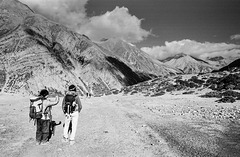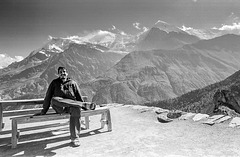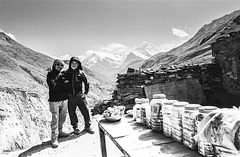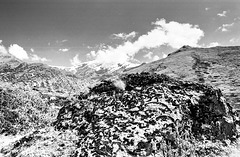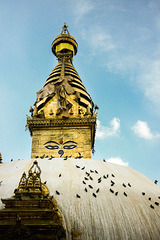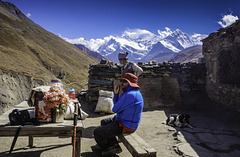
Nepal नेपाल
Velvet the Himalayan poinsettia in bloom,
silver the scabbard of thrusting power,
the mind is a clear scent,
the pen is a new ridge of hills.
I am a tree with countless boughs,
a flower which hides a thousand petals,
a juniper, a pointed branch of the scented fig,
its rough, misshapen fruit.
In my belief I am Nepali,
my faith the highest Himalaya,
my favourite season is the one
when leather jack…
(read more)
That direction for another 3 days...
| |
|
Somewhere between Manangand & Thorong Pedi appx…
Two strong men... and candies
| |
|
|
And here, I should take respect to these men who carried our staff while we were travelling light. Humble and good-spirited duo, after time spending home my respect only grows. Thanks to these people, we can enjoy the nature in its beauty - wish you guys a lot of safe future trips!
Swirls of high elevated plains
| |
|
|
You may not find many photos of this part of a circuit between Manang and Yak Kharka, as people have great views on the sharp peaks around and are focused on clicking selfies, yaks or panoramas. But this is a meditating part of a journey. These are a dry, high-elevated pastures where those who would not feel it, see it on a steeping price of water. But who'd remember the economics while overwhelmed by magic?
The Eyes on the Buddhist Stupa of Swayambhu, Kathm…
| |
|
|
|
Find peace and prayers on the little hillock of Swaymbhunath in the northwest of Kathmandu Valley. Visitors for whom the name was a tongue twister have called it "Monkey Temple" from the 1970s. Swayambhu, overlooks most parts of the valley giving visitors a panoramic view of the city. The stupa has stood as a hallmark of faith and harmony for centuries with Hindu temples and deities incorporated in this Buddhist site. The glory of Kathmandu Valley is said to have started from this point.
Resting on a hillock 3 km west of Kathmandu, Swayambhu is one of the holiest Buddhist stupas in Nepal. It is said to have evolved spontaneously when the valley was created out of a primordial lake more than 2,000 years ago. This stupa is the oldest of its kind in Nepal and has numerous shrines and monasteries on its premises.
Swayambhu literally means "self-existent one". Believed to date back to 460 A.D., it was built by King Manadeva and by the 13th century, it had become an important center of Buddhism. Legend has it that Swayambhu was born out of a lotus flower that bloomed in the middle of a lake that once spread across the Kathmandu Valley once was. The largest image of the Sakyamuni Buddha in Nepal sits on a high pedestal on the western boundary of Swayambhu beside the Ring Road. Behind the hilltop is a temple dedicated to Manjusri or Saraswati - the Goddess of learning. Chaityas, statues and shrines of Buddhist and Hindu deities fill the stupa complex. The base of the hill is almost entirely surrounded by prayer wheels and deities. Devotees can be seen circumambulating the stupa at all times.
Ivan rests
| |
|
|
Michal walks around the old village
| |
|
|
Phewa Tal
| |
|
|
|
Phewa Lake (Tal) is a freshwater lake in Nepal formerly called Baidam Tal located in the south of the Pokhara Valley. The lake is stream-fed but a dam regulates the water reserves, therefore, the lake is classified as semi-natural freshwater lake. It is the second largest lake in Nepal; the largest in Gandaki Pradesh after the Rara lake in the comparison to Nepal's water bodies. It is the most popular and most visited lake of Nepal. It is the only lake in Nepal to have a temple (Tal Barahi Temple) at the central part of lake. Phewa lake is located at an altitude of 742 m and covers an area of about 4.43 km2. It has an average depth of about 8.6 m and a maximum depth of 24 m. The Annapurna range on the north is only about 28 km (linear distance) away from the lake. The lake is also famous for the reflection of mount Machhapuchhre and other mountain peaks of the Annapurna and Dhaulagiri ranges on its surface.
Jump to top
RSS feed- Latest items - Subscribe to the latest items added to this album
- ipernity © 2007-2024
- Help & Contact
|
Club news
|
About ipernity
|
History |
ipernity Club & Prices |
Guide of good conduct
Donate | Group guidelines | Privacy policy | Terms of use | Statutes | In memoria -
Facebook
Twitter

